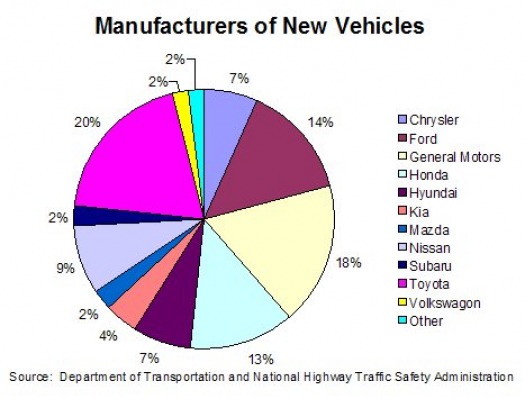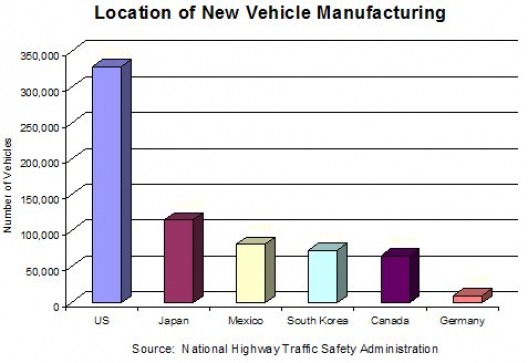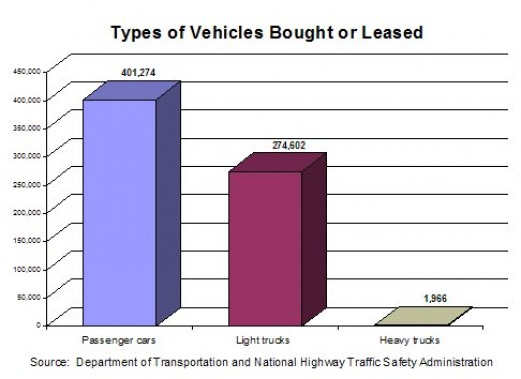Background
Chrysler and General Motors are two US automobile manufacturers that have been around since 1925 and 1908, respectively. Both headquartered in Detroit, they have grown to become two of the largest domestic automobile manufacturers. In 2008, GM was actually ranked the US' largest and the world's second largest automaker. However, during the 2000's both companies experienced a general decline in sales, and eventually they filed for Chapter 11 bankruptcy in 2009 (Chrysler on April 30th and GM on June 1st). The following graph shows annual sales for the two companies from 1999 to 2009.
The US government chose to bailout these large companies, helping them to reorganize. From the federal government, $16.9 billion and $57.6 billion was spent on Chrysler and GM, respectively. Through the Troubled Asset Relief Program (TARP), the US Treasury still temporarily owns a majority of GM. The Canadian government also holds a small stake in the company.
With Chrysler and GM struggling, total US retail car sales dropped. This can be seen in the following graph.
With Chrysler and GM struggling, total US retail car sales dropped. This can be seen in the following graph.
The Facts
On June 24, 2009 President Obama signed the Consumer Assistance to Recycle and Save (CARS) Act. Following that, Ray LaHood, Secretary of Transportation, used the National Highway Traffic Safety Administration (NHTSA) to create the Car Allowance and Rebate System (CARS). This program quickly became known as Cash for Clunkers.
There were two main goals of the program: increase the demand in domestic vehicles to stimulate the economy and get consumers to drive more fuel efficient vehicles. Funded by the US government, this was a rebate program in which consumers could trade in their used gas-guzzlers and receive a $3,500 or $4,500 voucher for the purchase or lease of a new more fuel efficient vehicle. The Enivronmental Protection Agency (EPA) decided which cars qualified based on their gas mileage. Their combined average for trade-ins was 24.9 MPG and 15.8 MPG for the new purchased and leased vehicles.
The following is requirements for the trade-ins.
There were two main goals of the program: increase the demand in domestic vehicles to stimulate the economy and get consumers to drive more fuel efficient vehicles. Funded by the US government, this was a rebate program in which consumers could trade in their used gas-guzzlers and receive a $3,500 or $4,500 voucher for the purchase or lease of a new more fuel efficient vehicle. The Enivronmental Protection Agency (EPA) decided which cars qualified based on their gas mileage. Their combined average for trade-ins was 24.9 MPG and 15.8 MPG for the new purchased and leased vehicles.
The following is requirements for the trade-ins.
- Drivable
- Registered and insured for at least a year previous to the trade-in
- Less than 25 years old
- Combined EPA average of 18 MPG or less
The next couple of graphs show what types of vehicles were being bought and leased. Clearly, the vast majority of these were domestically manufactured vehicles.
Most of these new vehicles were passenger cars, rather than trucks.
The Current State of CARS and Similar Programs
The CARS program was cut short and ended on August 24, 2009. However, there has been some discussion of whether or not the US government should start a Cash for Clunkers program later in 2010. Surveys show that about half of US car dealerships would like to participate in another CARS program.
Although the CARS program has ended (for now), similar rebate programs are currently running. Through the EPA and Department of Energy (DOE), Energy Star is offering sales tax exemptions or credits for purchasing energy efficient appliances to replace used ones. This program is being funded by $300 million under the American Recovery and Reinvestment Act. Below is a list of approved appliances.
Although the CARS program has ended (for now), similar rebate programs are currently running. Through the EPA and Department of Energy (DOE), Energy Star is offering sales tax exemptions or credits for purchasing energy efficient appliances to replace used ones. This program is being funded by $300 million under the American Recovery and Reinvestment Act. Below is a list of approved appliances.
- Boilers
- Central air conditioners
- Washing machines
- Dishwashers
- Freezers
- Furnaces (oil and gas)
- Heat pumps (air source and geothermal)
- Refrigerators
- Room air conditioners
- Water heaters
Analysis of Sustainability
Although the CARS program was started under good intentions, it had many problems. First, to prevent fraud the government wrote 135 pages of detailed strict rules for the program participants and dealerships. The overwhelming information led to confusion among the dealers, and thousands of applications were done incorrectly and had to be resubmitted. Unfortunately, those rules were continuously being revised, making things even harder. Second, there were technological issues. The website used to check the eligibility of possible participants crashed and froze frequently. Other times the website was down when the program rules were being revised.
Logistically, the program had many flaws. The government underestimated the number of willing participants. Thus, the original funding of $1 billion that was meant to last 6 months, lasted one week, and the additional $2 billion did not even last a month. With higher demand than expected, the NHTSA was unprepared in reviewing the submitted applications and sending the credit to the car dealerships. They eventually enlisted the help of Department of Transportation and Federal Aviation Administration employees. Nonetheless, when the program ended on August 24th only 75,000 of the 690,000 applications had been reviewed. Many dealers are still waiting on the government to credit them for the transactions they had processed.
As far as the government's goals of CARS, examining the behavior of individuals shows how their objectives cannot be fully achieved. In attempts to stimulate the US economy, the CARS program was meant to increase the demand for domestic vehicles. It did; however, some people that bought or leased a new car through Cash for Clunkers would have spent their money otherwise. Meaning, not all of the purchases through CARS could be considered an increase in demand because they were substitutes for other goods and services. Also, the rebound effect weakens the possible benefits to the environment with the use of more fuel efficient vehicles. In other words, people are driving cars with better gas mileage, so they actually might end up driving more because they are having to buy gas less often.
The final major problem with this program, however, was the disadvantages it caused for low-income consumers. These are people who could not participate in CARS because they cannot afford a new vehicle; they rely on the resale market. Because the trade-ins were sent to disposal facilities and destroyed after 180 days, the supply of used cars declined, making it harder for consumers to find. Also, the decrease in supply of used cars caused the prices of the ones remaining on the resale market to rise. Thus, the used cars people could find were more expensive. Unfortunately, with the trade-ins being destroyed, the amount of car parts available for low-income consumers to keep their current vehicles running decreased. This also hurt the disposal facilities that usually benefit from the sell of these used car parts.
Clearly, the Cash for Clunkers program created many problems within the economy, not to mention the fact that it did not run as smoothly as the US government had predicted. It is fueled with good intentions, but in the end is not a sustainable program. This is mainly due to the negative effects on low-income car buyers and the resale market, as well as the market for used car parts. The $3 billion of federal funding lasted only a month, so for the program to run an entire year, it would cost an estimated $36 billion. With all its issues and few benefits, such an expensive program cannot be on-going.
Logistically, the program had many flaws. The government underestimated the number of willing participants. Thus, the original funding of $1 billion that was meant to last 6 months, lasted one week, and the additional $2 billion did not even last a month. With higher demand than expected, the NHTSA was unprepared in reviewing the submitted applications and sending the credit to the car dealerships. They eventually enlisted the help of Department of Transportation and Federal Aviation Administration employees. Nonetheless, when the program ended on August 24th only 75,000 of the 690,000 applications had been reviewed. Many dealers are still waiting on the government to credit them for the transactions they had processed.
As far as the government's goals of CARS, examining the behavior of individuals shows how their objectives cannot be fully achieved. In attempts to stimulate the US economy, the CARS program was meant to increase the demand for domestic vehicles. It did; however, some people that bought or leased a new car through Cash for Clunkers would have spent their money otherwise. Meaning, not all of the purchases through CARS could be considered an increase in demand because they were substitutes for other goods and services. Also, the rebound effect weakens the possible benefits to the environment with the use of more fuel efficient vehicles. In other words, people are driving cars with better gas mileage, so they actually might end up driving more because they are having to buy gas less often.
The final major problem with this program, however, was the disadvantages it caused for low-income consumers. These are people who could not participate in CARS because they cannot afford a new vehicle; they rely on the resale market. Because the trade-ins were sent to disposal facilities and destroyed after 180 days, the supply of used cars declined, making it harder for consumers to find. Also, the decrease in supply of used cars caused the prices of the ones remaining on the resale market to rise. Thus, the used cars people could find were more expensive. Unfortunately, with the trade-ins being destroyed, the amount of car parts available for low-income consumers to keep their current vehicles running decreased. This also hurt the disposal facilities that usually benefit from the sell of these used car parts.
Clearly, the Cash for Clunkers program created many problems within the economy, not to mention the fact that it did not run as smoothly as the US government had predicted. It is fueled with good intentions, but in the end is not a sustainable program. This is mainly due to the negative effects on low-income car buyers and the resale market, as well as the market for used car parts. The $3 billion of federal funding lasted only a month, so for the program to run an entire year, it would cost an estimated $36 billion. With all its issues and few benefits, such an expensive program cannot be on-going.





